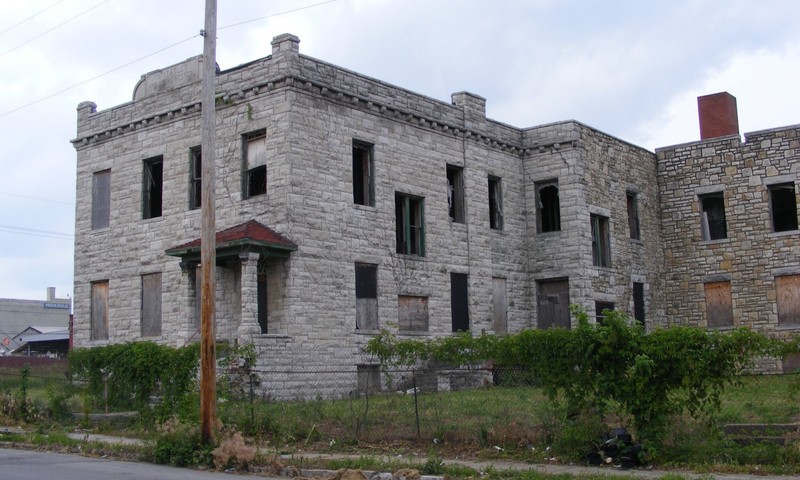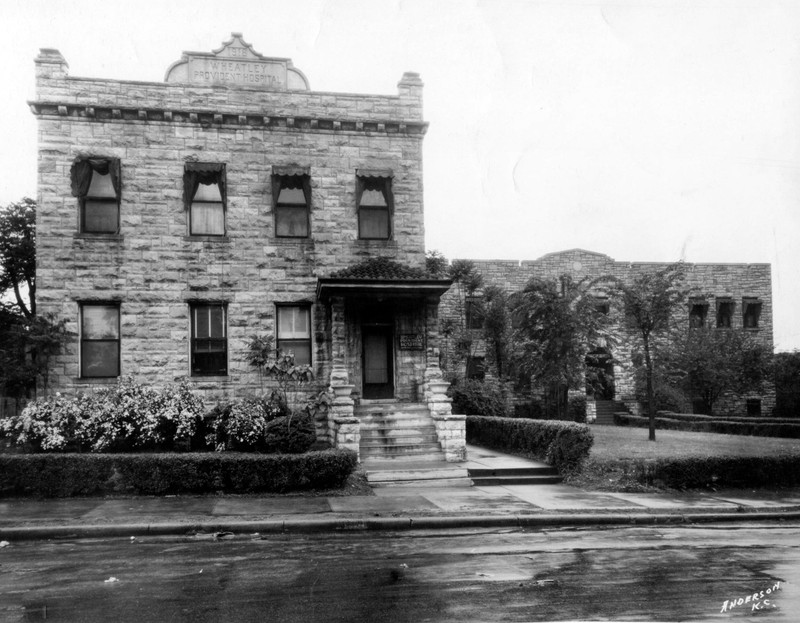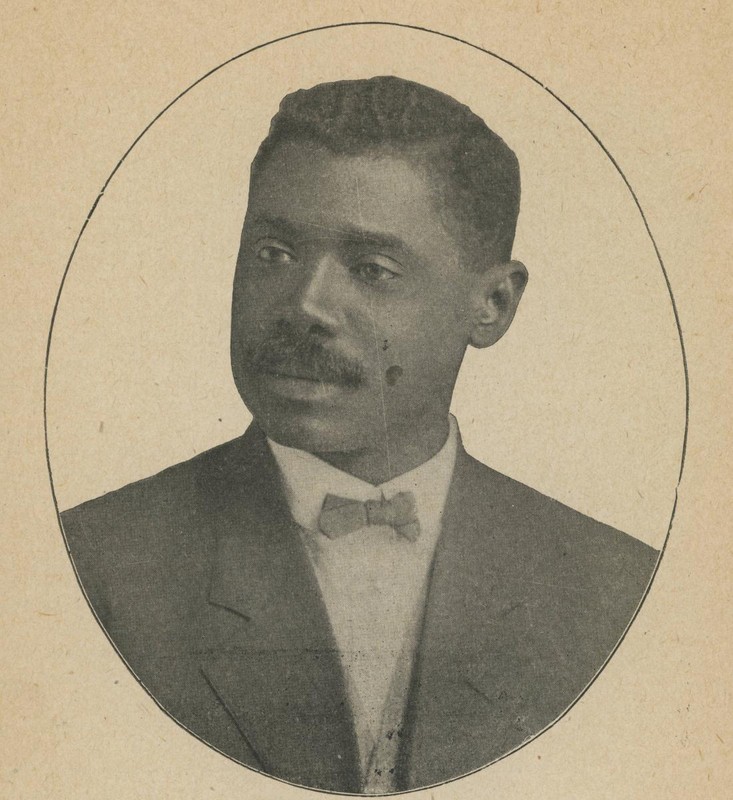Wheatley-Provident Hospital
Introduction
Text-to-speech Audio
Wheatley-Provident Hospital opened in 1918 as Kansas City's first hospital for African American residents in the era of segregation. Construction of this building occurred in 1902 for St. Joseph's Parochial School before its conversion to a hospital that became one of the cornerstones of the city's Black Communities. The hospital's origins also date back to 1902, the year when J. Edward Perry established a hospital and training school for nurses. Known as the Perry Sanitarium in 1910, that institution provided a place for training and employing doctors and nurses in addition to providing the first place where people of color could reliably receive healthcare in an era when hospitals largely barred access to African Americans, sometimes even denying or delaying service in cases where life-saving medical intervention was needed. With the support of Kansas City organizations and philanthropists, Dr. Perry moved his organization to this building which served as the home of Wheatley-Provident hospital from 1918 until 1972. After the 1970s, the building was used as a haunted house before eventually falling into disrepair. A group recently purchased the building to save it from the wrecking ball and they hope to restore the building and return it to service to the community. As a result, the brick building survives as a lasting reminder not only of segregation and exclusion, but also the vital role of Black institutions that served the people of Kansas City.
Images
Wheatley-Provident Hospital

Wheatley-Provident Hospital

Dr. J. Edward Perry

Backstory and Context
Text-to-speech Audio
Wheatley-Provident Hospital opened in 1918 as Kansas City's first hospital for Black people, emerging in an era when schools and hospitals largely denied access to African Americans; it served the Black Community until 1972. Construction of the building occurred in 1902, and it first operated as St. Joseph's Parochial School until Dr. Perry and his supporters secured the building. After the 1970s, the building was used as a haunted house before eventually falling into disrepair. A group recently purchased the building to save it from its demise. It survives as a lasting reminder of Perry's work, as well as the differences in health care between White and Black Americans, including in Kansas City.
Before 1900, the Kansas City General Hospital, the city's only public healthcare institution, had five beds to serve 18,000 African Americans. Dr. John Edward Perry sought to challenge the inequality of healthcare access between White and Black Americans. During the early twentieth century, the vast majority of hospitals in the U.S. either refused to treat African Americans, or only did so in separate and unequal wings.
Perry understood discrimination personally. Born in 1870 to two former slaves in Clarksville, Texas, he pursued a medical degree from Meharry Medical College. Upon graduation, Perry experienced discrimination when applying for positions at hospitals across the country. In some cases, medical institutions accepted Perry only to turn him away once they discovered he was Black. In 1902, after moving to Kansas City, he and his wife Fredericka Douglass Sprague Perry, daughter of Rosetta Douglass and granddaughter of Frederick Douglass, opened Perry Sanitarium and Nurse Training Association, a small hospital and training school for nurses on 12th & Vine. Dr. Perry also established a private practice at his home. Given the discrimination he faced after graduation, he understood the need to not only treat patients but train medical professionals. His small private hospital served an important need by offering a place for nurses in training to gain practical experience.
After a few years, the facility proved too small, so Perry initiated a fundraiser drive to help secure a new location, and that led to the acquisition of the former St. Joseph's Parochial School. They moved into the now-historic building in 1918 and later added a children's wing with help from the Phyllis Wheatley Club, an African American women's organization, and New Movement Association, an elite African American group; they renamed it the Wheatley-Provident Hospital. In 1922, Dr. Katharine Berry Richardson, the founder of Children's Mercy Hospital, realized a high demand existed for treating African American children in Kansas City. She could not convince Children's Mercy Hospital to accept Black children as the hospital board feared it would jeopardize funding from some of their white patrons. With equality denied by the hospital she helped establish, Dr. Richardson sought donors and raised funds to build a new pediatric department at Wheatley-Provident Hospital. With the support of diverse residents of Kansas City, the children's wing opened in 1926.
By 1936, Wheatley-Provident Hospital stood one of the nation's 122 hospitals owned and operated by African Americans and one of only sixteen such hospitals in the country to receive an "A class" rating by the American College of Surgeons. Perry worked at the hospital until he died in 1962. During his six decades of service, Dr. Perry not only treated patients, but he also trained scores of medical professionals. The hospital stayed open for few years after his passing, but the outdated facility no longer proved adequate. By the time it closed in 1972, the hospital had treated more than 50,000 patients.
In 1972, Wheatley-Provident closed and moved its operations to the newly-built Martin Luther King Jr. Hospital. After sitting vacant for a few years, the abandoned hospital briefly served as a haunted house, known as The Asylum in the '80s and Dr. Deadly's Haunted Hospital in the '90s. In 2012, the building was set on fire twice on the same day. An absentee landlord further led to the building's deterioration, leading the building the be declared a hazardous building and threatened with demolition by 2017. But, a group of investors purchased the building in 2018 to restore the building and preserve its legacy.
Sources
Collison, Kevin. "Kansas City's First Black Hospital Is Saved Thanks To Redevelopment Deal." KCUR/NPR. kcur.org. July 16, 2018. https://www.kcur.org/economy/2018-07-16/kansas-citys-first-Black-hospital-is-saved-thanks-to-redevelopment-deal.
Lenhausen, Emily and Rachel Nugent. "Nomination Form: Wheatley-Provident Hospital." National Register of Historic Places. mostateparks.com. 2020. https://mostateparks.com/sites/mostateparks/files/Wheatley-ProvidentHospital.pdf.
Historic Wheatley Provident Hospital website. Accessed October 15, 2021. https://www.wheatleyprovident.com/
"Wheatley Provident Hospital." AbandonedKS.com (blog). Accessed October 15, 2021. https://abandonedks.com/wheatley-provident-hospital/.
"Wheatley Provident Hospital: 1826 Forest Avenue." African American Heritage Trail of Kansas City. aahtkc.org. Accessed October 15, 2021. https://aahtkc.org/wheatleyprovidenthospital.
African American Heritage Trail -- https://aahtkc.org/wheatleyprovidenthospital. See URL for many more images.
African American Heritage Trail -- https://aahtkc.org/wheatleyprovidenthospital. See URL for many more images.
Photo shared with the Kansas City Public Library via the American Jazz Museum
